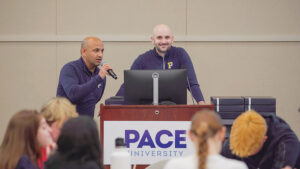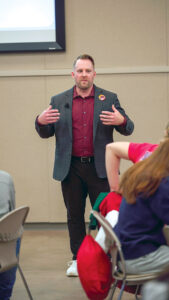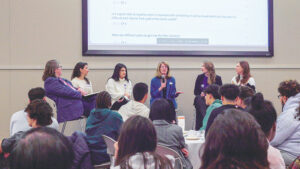In the AV industry, we’ve all heard a common refrain: “I found this industry by accident.” But what if more people deliberately chose AV as a career, instead of just stumbling upon it? What if more young, talented people joined the workforce earlier on and helped transform the industry into something bigger than it already is?
Key organizations, such as Pace University and Crestron, are doing just that. These organizations have already launched several training programs and certifications meant to empower young people to learn the inner workings of the AV industry. Now, they’re going a step further by bringing these programs to the classroom level. In fact, Pace University has launched a minor in AV for undergraduate students, while Crestron has partnered with other universities and technical institutes to enhance students’ technical skills via Crestron’s certification programs.
To get a firsthand perspective of how these programs are changing students’ lives and the AV industry itself, Commercial Integrator sits down with Pace University’s George Chacko and Rich Miller III, as well as Crestron’s Richard Sasson. Together, they explain the importance of building an AV curriculum track if we hope to hand the baton to the next generation.
Pace-ing the AV Track
“George and I always [have] prided ourselves on being futuristic thinkers, and [we like] testing the limits of what we can do,” begins Miller, IT director and adjunct professor, Pace University, as well as one half of the Bald AV Guys. “With our forward-thinking approach, we really wanted to push our limits when it came to AV education.” According to Chacko, director of IT and adjunct professor, Pace University, who is the other half of the Bald AV Guys, certifications (e.g., CTS) were of course available for AV professionals. However, there was no proper educational degree that catered specifically to the AV sphere.

Professors George Chacko (left) and Rich Miller III believes that, when it comes to providing access to education about AV careers, it should be a collective effort — not an individual effort. These programs will help us build a better future for our industry. Photo by Wes Brown.
“We wanted to develop a traditional learning process,” he explains. “And so, when the pandemic hit, we took the plunge and developed a syllabus.” From there, Chacko reveals, the Media Communications and Visual Arts (MCVA) department chair, Paul Ziek, took an interest in crafting a course that focused on audiovisual skills. “He recognized [our course] as a need and immediately jumped onboard to partner with us,” Chacko adds.
That partnership led to the formation of a three-credit course, MCA 165, entitled “Introduction to the Audio Visual Industry in the Media.” It provides students with a hands-on view of the AV field as it relates to the media, communications and educational-service industries. “We reached out to AVIXA — a great partner — and they provided us with a ton of material at no cost for all students,” Miller states. “They also gave us access to their AV Technologist Certificates so that students could walk away with a certificate right off the bat.”
Pace University’s A/V Talent Summit: Changing the Scope of Career Fairs
By all accounts, Pace University’s first-annual A/V Talent Summit was a huge success. From the interactive keynote by Crestron’s Chris Fitzpatrick — during which he leveled with the audience by admitting that the AV industry needs the younger generation more than they need the AV industry — to the panel discussions that followed, the content program engaged the young women and men in attendance. And, hopefully, the presentations inspired some thought. Promisingly, the students in attendance reflected diversity across every metric, offering the hope of a better, more equitable industry in coming years.
Among the panelists and presenters were Kristin Bidwell, CTS; Brittany DiCesare, CTS; Dr. Beth Gordon; Gina Sansivero; and Jennifer Weaver. In a panel emceed by AVNation’s Tim Albright, they offered personal testimonies of how they found their way into the industry and shared the advice that they’d bestow to others. These powerful women in AV underscored the value of internships and mentorship again and again, and they invited the “AV curious” to check out #AVintheAM on Sunday morning to see what the #avtweeps community is all about.
Meanwhile, it was wonderful to see Jabra’s Sharath Abraham lead a panel populated by Pace students, who shared their own thoughts on how they’re laying the groundwork for their career and how the pro AV industry could entice them. One female student simply said, “A lot more colleges should have audiovisual technology programs,” while emphasizing that these programs should also offer hands-on training opportunities. This is a statement that the industry has rallied behind for years; however, it was refreshing to hear it from a student’s own voice.
Only the Beginning
From Miller’s perspective, this is only the beginning. “We want to keep building this 100-level course to an eventual major,” he reveals. “We’re actually excited to launch our 400-level course, which is the AV apprenticeship, where students have the opportunity to work as an intern at a warehouse.” As part of the apprenticeship, Miller adds, students actually get to work directly under Chacko and him, while receiving credit. “Most importantly, they will have a full, hands-on experience of the AV world,” he enthuses.
According to Chacko, the biggest highlight of the current 100-level course is the “AV Olympics,” which is a culmination of all the topics covered throughout the course. “We divide the students into groups and then basically dump all the technology in the middle of the room,” he explains. “Each team has a different project, and the project manager is responsible for ensuring that the right technology is brought to the team in one shot.” Chacko explains that students are allowed to step outside and come back with more equipment, but they lose points for doing so. In essence, the AV Olympics tests the students’ skills across all technological categories, including video, audio, streaming and project management.
Both Chacko and Miller further opine that the AV Olympics challenges students, while allowing them to envision several innovative strategies. “One student was extremely smart,” Chacko reveals. “Once she was outside, she never came back in. She essentially broke the system!” In fact, Chacko and Miller have been continually impressed by student performance, despite the challenging assignment. According to Miller, “We threw many curveballs — [we] even included AV math, (because who doesn’t love math!) — and they took it all in their stride.”
Chacko and Miller agree that the AV Olympics was a huge hit among the students. “It gave [the students] a glimpse of a real-life AV scenario and truly built their knowledge and confidence,” Miller says. “We definitely look forward to incorporating and expanding it for our other courses.”
Crestron’s Outreach to Trade Schools

Crestron is committed to forging a tangible career path for students, whether they’re attending a university, high school or trade school. Chris Fitzpatrick, who attended the Pace summit, is a champion of this effort. Photo courtesy of Wes Brown.
Tapping a similar vein, Crestron has sought to bring the AV world to students at all levels, including those in high school and attending community colleges. Richard Sasson, Crestron’s global director, pro community, remarks, “Although [colleges and universities] teach broadcasting — a typeset of AV — there is no recognized education path for AV.” Commending Miller and Chacko’s efforts at Pace, he adds that efforts to impart a well-rounded education program are starting to pick up. “At Crestron, too, we’re working with Warren High School, [which] now has a fully accredited AV education program,” Sasson states. “We are also working with Sheffield Institute and Lincoln Technical Institute to bring our training programs [to] their institutions.”
According to Sasson, there is certainly a demand for AV education at all ends of the spectrum. “Everywhere we go, there is AV surrounding us,” he enthuses. “And we need the success and power of educating the next generation as new influences and technologies arise.” Sasson emphasizes a key hope of his: “…that we can bring in the younger generation and set them up for a phenomenal career — not one that they stumbled into.”
Turning to the details of the training program itself, Sasson explains that the career-based educational training stems from Crestron’s other training programs, focused on programming its products. “It evolved from teaching how to install and program Crestron products to [how to] design, commission, sell and be successful with our portfolio and platform,” he states. “We saw this as an opportunity to bring to the next generation the skills required to be a technician, designer or programmer.”
Forging a Tangible Career Path
From Sasson’s perspective, the idea is to forge a tangible career path for students, whether they’re attending a university, high school or trade school. “Audiovisual technology is such an important trade, and it involves more than just AV,” he explains. Indeed, Sasson says that students in the program learn how to examine a room or an office and recognize all the aspects needed to transform it into a fully functional space. “We are focused on providing that hands-on experience,” he states. “And some students are actually configuring systems from scratch.” Like Miller and Chacko, Sasson believes that offering a broad range of certifications and coursework will considerably enhance the quality and breadth of students’ skill sets.
For the students, the experience has been nothing short of exceptional. “They have enjoyed working with different kinds of technology, along with learning beyond just AV,” Sasson proclaims. “They have picked up the integration of security [and] fire alarms, as well as HVAC systems, after which they ultimately choose their specialization.” He further propounds that these skills do not just apply to the AV industry but also to any industry in general. “We’re essentially equipping the next generation with the power of technology and letting them lead the way forward,” Sasson underscores.

During the A/V Talent Summit at Pace University, some of our industry’s female luminaries spoke directly to young girls and members of marginalized communities about how they can forge their own path into the AV industry. Photo courtesy of Wes Brown.
Looking to the Future
According to all of our interviewees, currently existing AV education programs are just the preamble to the burgeoning rise of education tracks in AV. Chacko affirms that development plans are in place to eventually launch a full major track in AV at Pace University. He remarks, “We took around two years to conceptualize the minor, and we anticipate taking a lot longer [to build] the major track.” Regardless, Chacko and Miller are both extremely keen to continue the groundwork on the education side. “Who knows?” Miller chimes in. “Perhaps we may have a master’s program soon!”
This enthusiasm also carries over to efforts to raise awareness among parents, friends and other university departments. For instance, Miller and Chacko hosted the inaugural A/V Talent Summit, where partner organizations presented education sessions and panel discussions. It was a perfect opportunity to appeal to students interested in the audiovisual realm. “We also handpicked students from the MCA 165 course for a panel discussion so that other attendees could gain a personal perspective,” Miller reveals. “We also had giveaway swag as a way of attracting a crowd and kickstarting a conversation centered [on] AV.”
The A/V Talent Summit was a major success, receiving immensely positive feedback from all attendees and participants. Reiterating the purpose of the event, Miller adds, “We want AV as a subject to be at the forefront of the students’ thoughts, and this event [allowed] us to do just that.”
Sasson, too, seeks to sow the proverbial seeds of AV by helping the next generation to be future-ready. Through this partnership with education institutions and dealers, he reveals, anyone with a company or school address can undertake the Crestron training program. “The best part is that the training follows the individual — not the company or school they worked at,” Sasson proclaims. “They can thus carry this experience on their resumes when advancing their career.”
Sasson underlines that the core idea is to bring everyone together in an effort to provide educational opportunities for the current generation’s successors in the AV sphere. “We’re all excited to be working together and helping [the youngsters] build successful careers because there is such a huge demand for those skilled resources in our industry,” Sasson says.
The Need for AV Education
According to Erin Maher-Moran, CTS, DMC-E, who is multimedia services manager at Johns Hopkins University, the emphasis on education in AV must go beyond just enhancing students’ skills and resources; it should also be about empowering them to rise to new heights in their careers. “For young girls and other marginalized communities, it is especially important to support them and give them a confidence boost,” she says. Thus, Maher-Moran hopes to see AV-related programs reach all the way to kindergarten, elementary school and middle school. She also spotlights the need for young girls in STEM to see role models, adding, “It’s always inspiring to see representation at that young age and know that you are capable of [reaching] similar heights.”
Additionally, Maher-Moran acknowledges the twofold benefits of training programs for AV’s next generation. “It helps us, as well!” she explains. “We get to see fresh innovations and perspectives that strengthen our operations.” In summation, Maher-Moran welcomes the efforts of Pace University, Crestron, AVIXA and other organizations that are striving to improve access to education in AV. “With this collaborative effort, we are well on our way to building a better future for all,” she concludes.
Closing Thoughts
As Sasson puts it, when it comes to education access, it should be a collective effort — not an individual effort. “This is about taking the industry forward and encouraging the next generation to influence and shape our trajectory,” he emphasizes. Chacko echoes that sentiment, noting that the goal is to “…lessen the gap [and the] talent shortage and grow the workforce.” Miller remarks, “It is ironic that, for such an unknown industry, the AV field will generate over $400 billion in revenue in 2028. It is time we shared this wonderful industry with the changemakers of tomorrow.”
Indeed, there is no better time than now to spotlight our industry to the next generation and, thus, bring them in. This vast industry, after all, has something for everyone. As Miller states, “We may have been the first ones to do [these programs]; however, we certainly won’t be the last!”










